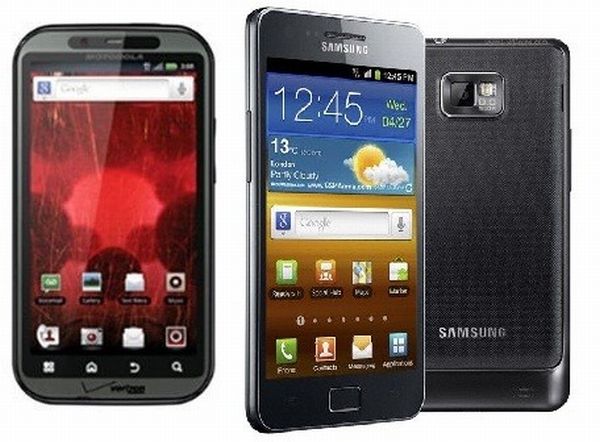
The challenge
Both Motorola Droid Bionic and Samsung Galaxy Nexus have dazzled smartphone customers with their impressive features. At the first glance, non-techie customers could hardly spot any difference between the two smartphones. Nonetheless, on a closer look, you would find several variations in the features and specifications of the two devices, which would help you to prefer one smartphone to another.
Round one
Comparison attributes
1. Size
Motorola Droid Bionic: The smartphone flaunts an elegant body, 127.5mm long, 66.9mm wide and 11mm thick. It weighs 158.8g.
Samsung Galaxy Nexus: The new Samsung smartphone comes with a 135.5mm long, 67.9mm wide and 8.9mm thick lightweight body, weighing 135g.
Winner: With a thinner and lighter body, Samsung Galaxy Nexus wins this round.
2. Display
Motorola Droid Bionic: The Motorola smartphone sports a 4.3-inch TFT LCD capacitive touchscreen display. With 16M colors support and 540 x 960 pixels resolution, the smartphone screen displays vibrant colorful visuals. Standard touchscreen components such as multi-touch sensors, accelerometer and proximity sensor are integrated in the smartphone display.
Samsung Galaxy Nexus: The high-resolution (720 x 1280 pixels), 4.65-inches capacitive touchscreen display of Samsung Galaxy Nexus is a miniature version of the HDTV screen. It is designed to display full high-definition movies. The 316 ppi pixel density does not compromise with the brightness of images. In addition, the Super AMOLED screen drains less battery power while producing brighter and more colorful pictures.
Winner: With almost 80 percent higher resolution, 20 percent higher pixel density and a larger Super AMOLED display, Samsung Galaxy Nexus wins this round.
3. Processor
Motorola Droid Bionic: Tegra 2 AP20H chipset with dual-core 1GHz ARM Cortex-A9 CPU and ULP GeForce GPU manages the robust performance of the Motorola smartphone.
Samsung Galaxy Nexus: To enable seamless performance without slowing down the smartphone while running demanding apps, Samsung has endowed Galaxy Nexus with TI OMAP 4460 chipset with dual-core Coretx-A9 processor clocked at 1.2GHz.
Winner: Equipped with a more powerful processor that boosts the speed and responsiveness of the smartphone by almost 20%, Samsung Galaxy Nexus wins this round.
4. Operating system
Motorola Droid Bionic: The Motorola Android phone runs on version 2.3.4 of the Android Gingerbread operating system.
Samsung Galaxy Nexus: It is the first smartphone to run on Android 4.0 Ice Cream Sandwich platform of Google.
Winner: Samsung Galaxy Nexus
5. Memory
Motorola Droid Bionic: Just like other high-end Android-based smartphones, Motorola Droid Bionic too comes with 1GB RAM to enable seamless multi-tasking speed. It offers 16GB onboard storage capacity. The external memory is expandable up to 32GB with microSD card. A 16GB memory card is preinstalled in the memory card slot.
Samsung Galaxy Nexus: The built-in 1GB RAM of the smartphone minimizes glitches while running multiple applications on the smartphone. Samsung Galaxy Nexus comes with either 16GB or 32GB internal memory. However, absence of memory card slot impairs memory expansion.
Winner: Flexibility in memory expansion has helped Motorola Droid Bionic to win this round.
6. Camera
Motorola Droid Bionic: Equipped with an 8MP rear-facing camera, the Motorola smartphone could generate striking stills. The imagery functions of the smartphone camera are aided by dual-LED flash, auto focus, face detection and image stabilizer. Geo tags could be added to the stills and videos with the assistance of the smartphone GPS. Droid Bionic users could compose 1080p full HD movies with the video recorder. A VGA camera is installed on the front.
Samsung Galaxy Nexus: The Android phone features a 5MP camera with auto focus, touch focus and LED flash. It flaunts geo-tagging and face detection features. The integrated video recorder generates 1080p full HD movies. Video calling is facilitated by a 1.3MP front-facing camera.
Winner: With higher sensor resolution, Motorola Droid Bionic wins this round.
7. Connectivity
Motorola Droid Bionic: The smartphone facilitates data sharing through 3G, Wi-Fi, Bluetooth 2.1 and microUSB 2.0.
Samsung Galaxy Nexus: 3G, Wi-Fi, Bluetooth 3.0 and microUSB 2.0 are the key connectivity attributes of Samsung Galaxy Nexus.
Winner: The latest Bluetooth version that facilitates faster data transfer without consuming excess battery power and the slightly fast data transfer speed have helped Samsung Galaxy Nexus to win this round.
8. GPS
Motorola Droid Bionic: The Motorola smartphone comes with A-GPS.
Samsung Galaxy Nexus: With the built-in GPS, Galaxy Nexus users could plan the routes to their destination.
Winner: A-GPS pinpoints locations faster than GPS. Hence, Motorola Droid Bionic has won this round.
9. Battery power
Motorola Droid Bionic: The 1735 mAh Li-Ion battery supports more than 10 hours of talk time and up to 195 hours of standby time.
Samsung Galaxy Nexus: The Samsung smartphone is powered by a 1750 mAh Li-Ion battery.
Winner: Samsung Galaxy Nexus
The Verdict
Powered by the upgraded Android operating system, a powerful processor and high-resolution display, Samsung Galaxy Nexus is better equipped for multi-tasking and running multimedia files.
